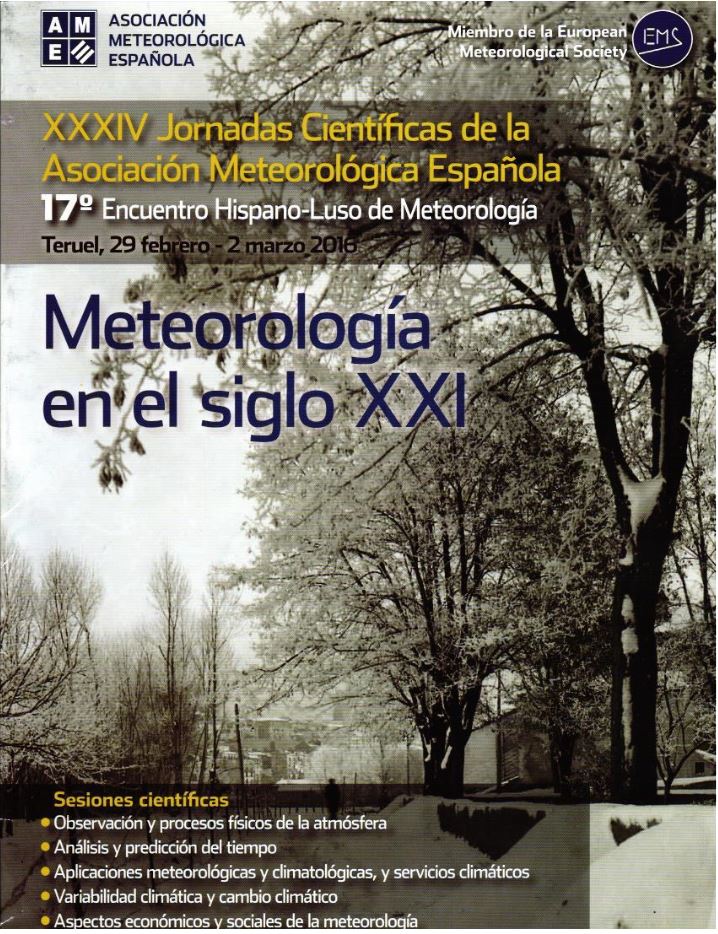La nueva generación de modelos climáticos. El proyecto europeo EC-Earth
Resumen
Los modelos climáticos globales constituyen la herramienta básica para estimar y obtener información sobre el clima futuro. Consisten en modelos acoplados atmósfera-océano (AOGCM, Atmosphere-Ocean Global Circulation Models) que tratan de describir y simular los distintos componentes del sistema climático, las interacciones entre ellos y su evolución. Con el paso de los años estos modelos han ido perfeccionándose, añadiendo nuevos componentes (hielo marino, esquemas de superficie mejorados, aerosoles atmosféricos, vegetación dinámica, química atmosférica, ciclo del carbono, biogeoquímica oceánica, etc..) así como una mayor resolución y complejidad a su estructura, en su objetivo de simular lo mejor posible los procesos físicos, químicos y biológicos que se dan globalmente en el sistema terrestre y sus procesos de realimentación asociados, dando lugar a los hoy llamados “Modelos del Sistema Tierra” o “Earth System Models” (ESM).En la actualidad, estos modelos son utilizados por múltiples sectores como herramienta para la toma de decisiones, con finalidades muy diversas (por ejemplo: planificación agrícola, energética y de infraestructuras; gestión hidrológica; seguros; evaluación de riesgos ambientales o de salud; mercados financieros; apoyo a modelos de impacto socio-económico, etc..)
Citas
Anderson, D., T. Stockdale, M. Balmaseda, L. Fe rranti, F. Vitart, F. Molteni, F. Doblas-Reyes, K. Mogensen and A. Vidard, (2007). Development of the ECMWF seasonal forecast System 3. ECMWF Technical Memorandum 503.
Brown, A., S. Milton, M. Cullen, B. Golding, J. Mitchell, and A. Shelly, (2012). Unified Modeling and Prediction of Weather and Climate. Bull. Amer. Meteor. Soc., 93, 1865–1877.
Dee, D. P., with 35 co-authors, (2011). The ERAInterim reanalysis: configuration and performance of the data assimilation system. Quart. J. R. Meteorol. Soc., 137, 553-597.
Du, H., F.J. Doblas-Reyes, J. García-Serrano, V. Guemas, Y. Soufflet and B. Wouters (2012). Sensitivity of decadal predictions to the initial atmospheric and oceanic perturbations. Climate Dynamics, 39, 2013-2023.
Guemas V, Doblas-Reyes F, Andreu-Burillo I., Asif M., (2013). Retrospective prediction of the global warming slown down in the past decade, Nature Climate Change, 3, 649–653.
Hazeleger, W., and Coauthors, (2010). EC-Earth: A Seamless Earth-system Prediction Approach in Action. Bull. Amer. Meteor. Soc., 91,1357–1363.
Hazeleger W., and Coauthors, (2011). EC-Earth V2.2: Description and Validation of a New Seamless Earth System Prediction Model. Clim. Dyn. 39, 2611–2629.
Hazeleger W, Bintanja R (2012). Studies with the EC-Earth seamless earth system prediction model. Clim. Dyn., 39:2609-2610.
Hazeleger, W., V. Guemas, B. Wouters, S. Corti, I. Andreu-Burillo, F. J. Doblas-Reyes, K. Wyser and M. Caian (2013). Multiyear climate predictions using two initialisation Strategies, Geoph. Res. Lett., DOI: 10.1002/grl.50355.
Hoskins BJ (2012). The potential for skill across the range of the seamless weather-climate prediction problem: a stimulus for our science. Q. J. R. Meteorol. Soc. 139: 573 – 584.
Hurrell, J. W., Meehl G. A., Bader D., Delworth T., Kirtman B., and Wielicki B., (2009). A Unified Modeling Approach to Climate System Prediction. Bull. Amer. Meteor. Soc., 90,1819–1832
IPCC, 2013: Climate Change 2013: The Physical Science Basis. Contribution of Working Group I to the Fifth Assessment Report of the Intergovernmental Panel on Climate Change [Stocker, T.F., D. Qin, G. K. Plattner, M. Tignor, S.K. Allen, J. Boschung, A. Nauels, Y. Xia, V. Bex and P.M. Midgley (eds.)]. Cambridge University Press, Cambridge, United Kingdom and New York, NY, USA, 1535 pp.
Jones, P.D., Lister, D.H., Osborn, T.J., Harpham, C., Salmon, M. and Morice, C.P. (2012). Hemispheric and large-scale land surface air temperature variations: an extensive revision and an update to 2010. Journal of Geophy. Research. 117.
Kållberg, P., (2013). Diagnostics of two EC_Earth historical simulations and four ‘System 4’ decadal predictions. Personal Communication.
Madec G. (2008). ‘‘NEMO ocean engine’’. Note du Pole de modelisation, Institut Pierre-Simon Laplace (IPSL), France, No 27. ISSN no 1288-1619
Molteni F, Stockdale T, Balmaseda MA, Balsamo G, Buizza R, Ferranti L, Magnusson L, Mogensen K, Palmer TN, Vitart F. (2011). ‘The new ECMWF seasonal forecast system (System 4)’. Tech. Memo. 656. ECMWF: Reading, UK
Palmer, T.N., Doblas-Reyes F.J., Weisheimer A. and Rodwell M.J., (2008). Toward Seamless Prediction: Calibration of Climate Change Projections Using Seasonal Forecasts. Bull. Amer. Meteor. Soc., 89, 459–470.
Rohde R, Muller R, Jacobsen R, Perlmutter S, Rosenfeld A, et al. (2013). Berkeley Earth Temperature Averaging Process. Geoinfor Geostat: An Overview 1:2
Shukla, J., T. N. Palmer, R. Hagedorn, B. Hoskins, J. Kinter, J. Marotzke, M. Miller, and J. Slingo, (2010): Climate prediction from weeks to decades in the 21st century: Towards a new generation of world climate research and computing facilities for climate prediction. Bull. Amer. Meteor. Soc., 91,1407–1412.
Sterl A., Bintanja R., Brodeau L., Gleeson E., Koenigk T., Schmith T., Semmler T., Severijns C., Wyser K., Yang S., (2012). A look at the ocean in the EC-Earth climate model. Clim. Dyn., 39, 26312657
Stockdale, T.N., D. L. T. Anderson, M. A. Balmase da, F. Doblas-Reyes, L. Ferranti, K. Mogensen, T.N. Palmer, F. Molteni and F. Vitart, (2011). ECMWF seasonal forecast system 3 and its prediction of sea surface temperature. Clim. Dyn.
Taylor K.E., Stouffer R.J., Meehl G.A., (2012). An overview of CMIP5 and the experiment design. Bull. Amer. Meteor. Soc., 93:485–498. doi:10.1175/BAMS-D-11-00094.1
Uppala, S.M. with 45 co-authors (2005). The ERA40 re-analysis. Quart. J. R. Meteorol. Soc., 131, 2961-3012.
van Vuuren DP, Edmonds J, Kainuma M, Riahi K, Thomson A, Hibbard K, Hurtt GC, Kram T, Krey V, Lamarque JF, Masui T, Meinshausen M, Nakicenovic N, Smith SJ, Rose SK (2011). The representative concentration pathways: an overview. Clim. Change 109:5–31.
------ AR5, Fifth Assessment Report. http://www.ipcc.ch/report/ar5/index.shtml
ECMWF (2006) IFS Cycle 31r1 documentation. Disponible en: http://www.ecmwf.int/research/ ifsdocs/CY31r1/index.html
IPCC, Intergovernmental Panel on Climate Change http://www.ipcc.ch/

